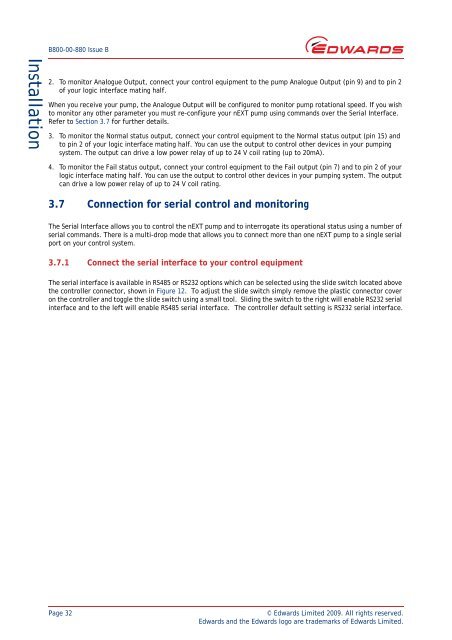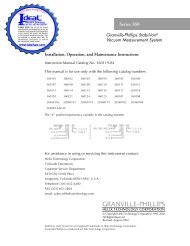Edwards, nEXT Turbomolecular Pumps, nEXT240, nEXT300 and ...
Edwards, nEXT Turbomolecular Pumps, nEXT240, nEXT300 and ...
Edwards, nEXT Turbomolecular Pumps, nEXT240, nEXT300 and ...
You also want an ePaper? Increase the reach of your titles
YUMPU automatically turns print PDFs into web optimized ePapers that Google loves.
B800-00-880 Issue B<br />
Installation<br />
2. To monitor Analogue Output, connect your control equipment to the pump Analogue Output (pin 9) <strong>and</strong> to pin 2<br />
of your logic interface mating half.<br />
When you receive your pump, the Analogue Output will be configured to monitor pump rotational speed. If you wish<br />
to monitor any other parameter you must re-configure your <strong>nEXT</strong> pump using comm<strong>and</strong>s over the Serial Interface.<br />
Refer to Section 3.7 for further details.<br />
3. To monitor the Normal status output, connect your control equipment to the Normal status output (pin 15) <strong>and</strong><br />
to pin 2 of your logic interface mating half. You can use the output to control other devices in your pumping<br />
system. The output can drive a low power relay of up to 24 V coil rating (up to 20mA).<br />
4. To monitor the Fail status output, connect your control equipment to the Fail output (pin 7) <strong>and</strong> to pin 2 of your<br />
logic interface mating half. You can use the output to control other devices in your pumping system. The output<br />
can drive a low power relay of up to 24 V coil rating.<br />
3.7 Connection for serial control <strong>and</strong> monitoring<br />
The Serial Interface allows you to control the <strong>nEXT</strong> pump <strong>and</strong> to interrogate its operational status using a number of<br />
serial comm<strong>and</strong>s. There is a multi-drop mode that allows you to connect more than one <strong>nEXT</strong> pump to a single serial<br />
port on your control system.<br />
3.7.1 Connect the serial interface to your control equipment<br />
The serial interface is available in RS485 or RS232 options which can be selected using the slide switch located above<br />
the controller connector, shown in Figure 12. To adjust the slide switch simply remove the plastic connector cover<br />
on the controller <strong>and</strong> toggle the slide switch using a small tool. Sliding the switch to the right will enable RS232 serial<br />
interface <strong>and</strong> to the left will enable RS485 serial interface. The controller default setting is RS232 serial interface.<br />
Page 32<br />
© <strong>Edwards</strong> Limited 2009. All rights reserved.<br />
<strong>Edwards</strong> <strong>and</strong> the <strong>Edwards</strong> logo are trademarks of <strong>Edwards</strong> Limited.
















